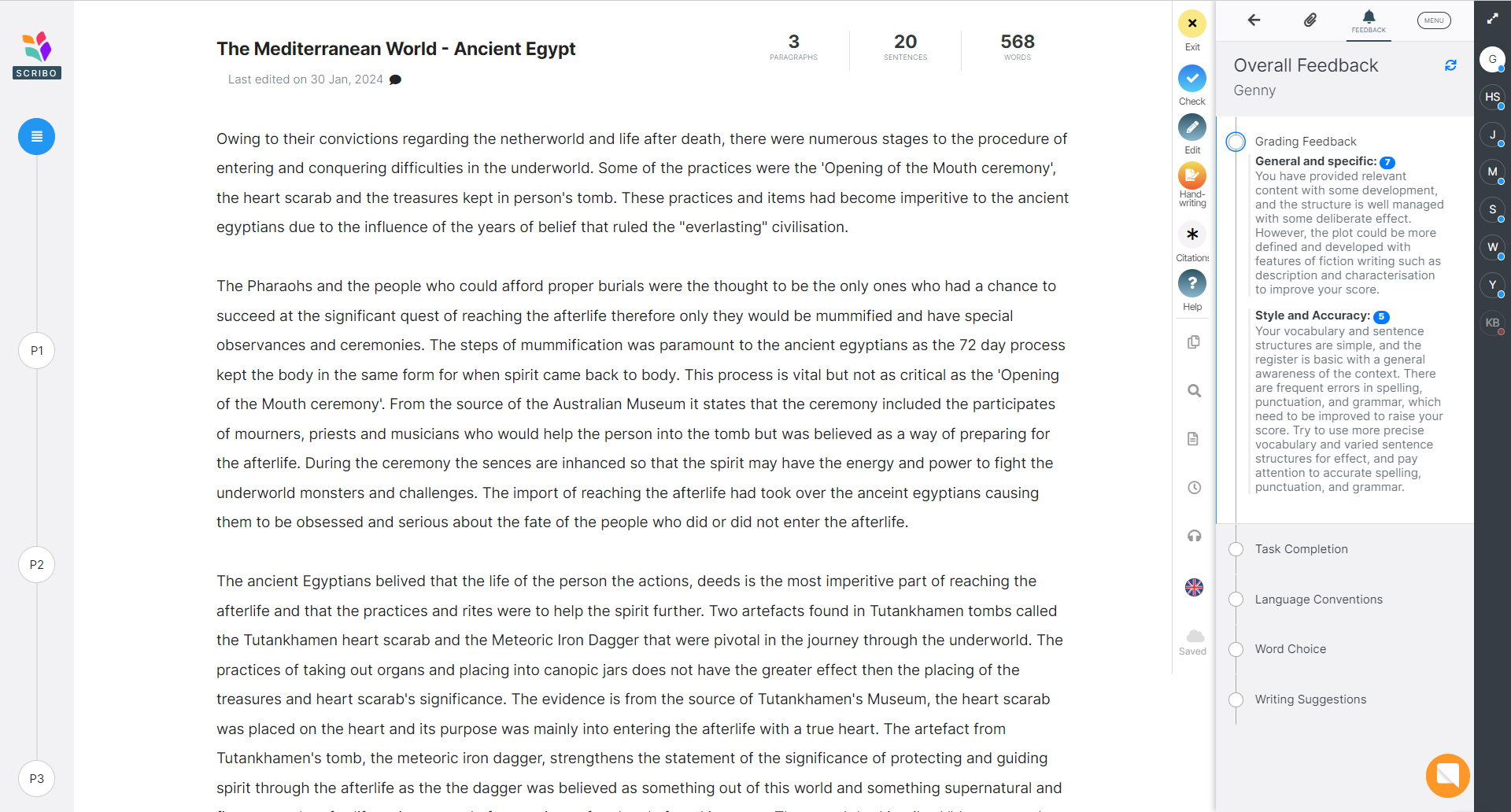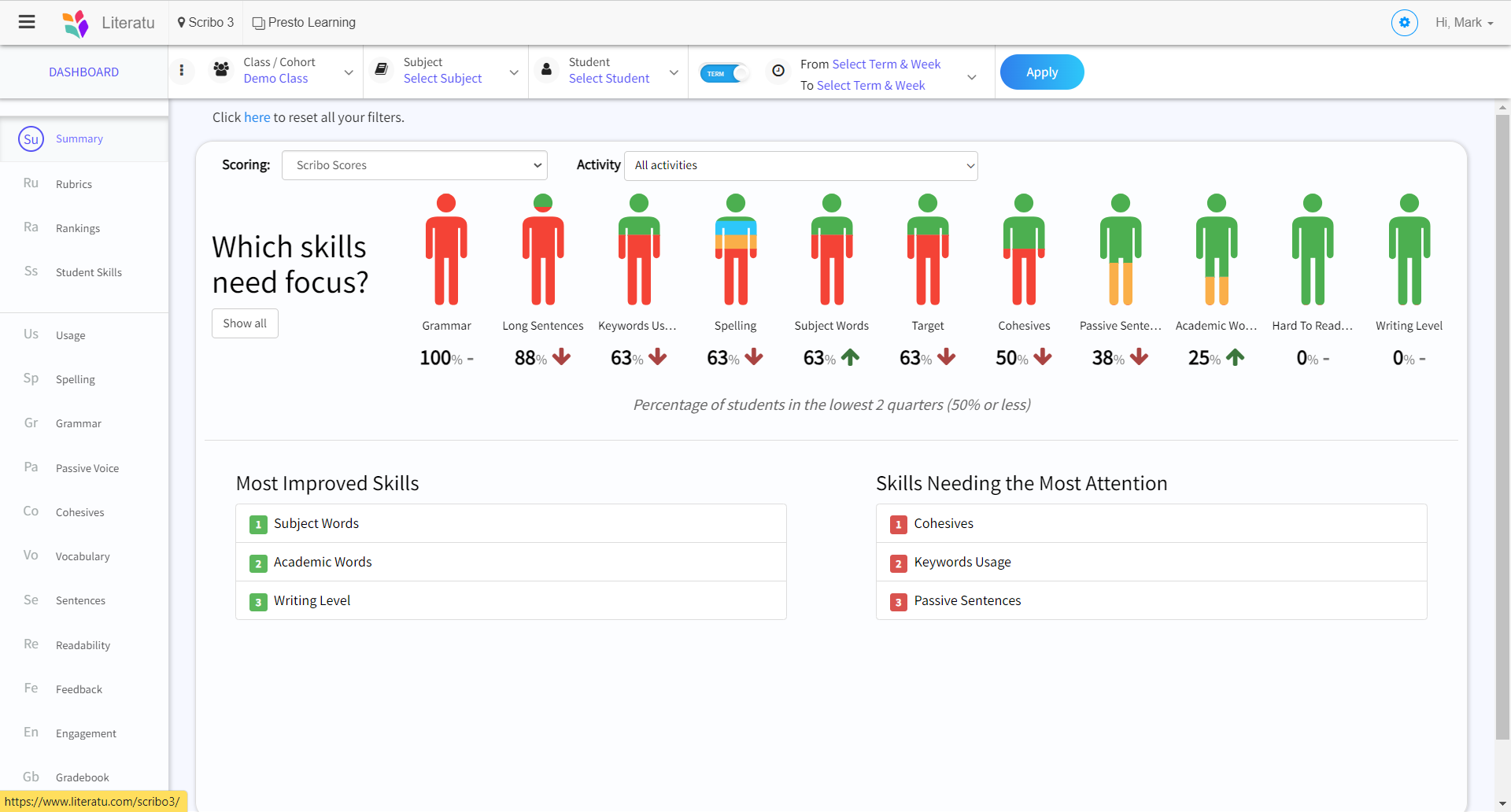Improving student writing abilities with AI
Hattie and Clarke (2019) found that while feedback is the most powerful influencer on learning, it is also the most variable. The conclusions they made based on the research are significant.
● About ⅓ of feedback doesn’t work because it’s negative.
● Feedback for one child does not work for another.
● The feedback you give today doesn’t work for tomorrow.
There is a fourth point to make about feedback and that is the tragic loss of this incredibly valuable information! Despite the time invested by teachers in giving feedback, it is typically lost amongst the hundreds of documents in which it is given. Feedback given in Scribo will never be lost, but rather enjoyed by all who give and receive it.
Creating well-formed and relevant feedback tailored to each student’s writing is time-consuming. Creating and delivering consistent and changing personalised feedback on demand for students is what Scribo AI does. The biggest challenges for teachers is keeping the feedback flowing in an open loop, keeping it relevant and differentiated. The objective of Scribo is to improve the timeliness, accuracy and usefulness of feedback for each student where they write, how they write, as they write.
Hattie and Clarke (2019) suggest good feedback should answer three questions to make it effective.
a. Where am I going?
b. How am I going?
c. Where should I go next?
Scribo builds all three levels of feedback, combining “Where am I going?” with “How am I going?”. The most important, “Where I should go next?”, is the critical piece of feedback that is most time consuming for a teacher, and the one Scribo does best. The most interesting finding from Hattie and Clarke (2019) is “If students don’t get ‘where to next’ feedback, they say they never got any feedback”. How many times do teachers hear that!
Aligning to each student’s skill and effort, feedback must offer students viable suggestions to improve their work as they work. Using each student’s text, Scribo applies AI to create and deliver an improvement context, rebuilding new feedback after each iteration of student revision to stay in step with the students’ text as they write.

Fig. 4 Screen capture of Writing Check
Alongside the generation of automatic feedback, each teacher’s own comments are quickly captured using a ‘talk-to-text’ recording capability, able to be aligned to specific aspects of writing (e.g., vocabulary, paragraphing, etc.). Furthermore, teachers can assign the comments to either individual students or the whole class when common issues are discovered.
This streamlines what can be a laborious process, but best of all, each comment is kept for later analysis by both teachers and students. The impact of saved and tracked feedback that is linked to instructional practices limits the ‘moving target’ aspect of teaching writing where the comments related to one task or student disappear and the challenge of building writing skills begins again with each text.
In a data-informed context, teachers gain quick insights into what’s working and how students are progressing, and can then share successful strategies with colleagues to help systemic improvement.
‘Feedback in the moment‘ is a term Hattie and Clarke (2019) use to describe useful feedback, and it describes how Scribo delivers and manages feedback beautifully.
Peer Review
Hattie and Clarke (2019) suggest the best feedback for students and teachers is the feedback they hear and see.
The question then becomes, “How do teachers and students hear and see the feedback happening around them?” Although teachers move around the classroom asking questions and giving feedback, the aim of the last twenty years has been to find more efficient ways to ensure all students get feedback, from the teacher and their peers, while they are in the process of learning.
The very essence of formative assessment feedback is the ability to react to the learning during the learning so it can be enhanced before it is too late (Hattie & Clarke, 2019).
The power of Peer Review in Scribo opens opportunities for students to metaphorically hear feedback via reflection and physically see and give feedback to peers in a constructive and simple workflow at any time during the writing process. Seeing alternative approaches in text is a powerful feedback mechanism in itself.
Hattie and Timperley (2007) argue that “less effective learners have minimal self-regulation strategies, and they depend much more on external factors for feedback” (p. 94). Peer review opens this external opportunity and is best led and moderated by teachers. Scribo opens a simple and powerful peer review capability to the classroom, bringing feedback into view and promoting self-regulation and discovery strategies (see Fig. 5).

Fig. 5 Screen capture of peer review
Peer review is quickly constructed and led by teachers. The value to students is seeing how other students are writing.
Step 3 – Data driven insights into learning
“Learning is the inevitable by-product of data.” Mark Stanley
Teachers often view data as the domain of data people. Nothing could be further from the truth.
The most atomic level of data in education is created through student engagement, and the best data is teacher-led. The obvious and immediate stakeholders in writing and learning data are the teachers and students. Scribo gives teachers and school leaders instant access to data on demand as teaching and learning happens. Learning is the inevitable by-product of data for all who can see the stories contained in the data.
Scribo builds a data schema underpinning all writing, using the consistency of the data collection as a primary input into the AI, ML and DL models that power deep learning networks and surface level inferences for data aggregations. There is no additional work for any teacher to aggregate learnings and insights into reflective analyses on how effective their teaching is and where they can target teaching for each student.
Without data across the breadth of elements that go into good writing, teachers are left to intuition and more hours of self-discovery. Scribo builds data from every student and teacher writing check, automatically presenting data in visible dissections for cohorts, subjects, teachers, year levels, schools and district level analysis.

Fig. 6 Screen capture of Scribo analytics
Data is collected across multiple writing elements and functional aggregations (see Fig. 6). Teachers at all levels of interest can hone into any level of inquiry, all the way down to student level.
Data really offers teachers a “Dynamic Ability To Affect” what happens next in pedagogy and practice. Scribo offers operational support to decisions and processes employed by teachers as they build writing skills in students.
Conclusion
Teaching writing is a hard and time-consuming job, however the importance, versatility and pervasiveness of writing exacts a toll on those who do not learn to write well, as this can limit academic, occupational, and personal attainments (Graham, 2006).
While children typically begin learning how to write at home (Tolchinsky, 2016), a basic aim of schooling is to teach students to become competent writers.
Do schools successfully meet this obligation?
The available evidence indicates that this objective is met for some students but not all. Scribo is a modern writing support platform using the abilities of AI to save teachers time, and help teachers at all levels of practice proficiency help students improve their writing skills. The sooner you have Assistive Intelligence working with you, the more time you will find for teaching.